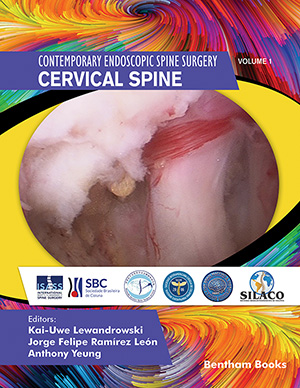Abstract
Percutaneous endoscopic cervical discectomy (PECD) was designed to bridge the gap between failed medical- and interventional care for cervical radiculopathy due to small herniated discs and traditional open anterior cervical discectomy surgery many of which employ fusion and far fewer motion preservation strategies. PECD can be divided into the anterior transdiscal- and the posterior interlaminar approach. Anterior PECD has been criticized for the potential propagation of cervical disc collapse due to the more aggressive disruption of the anterior annulus. Additional limitations of the anterior transdiscal PECD may become relevant when upward or downward disc fragments are entrapped behind the vertebral body. Even during ACDF, a corpectomy may be required to remove these far-migrated disc fragments. Therefore, the authors advocated for the anterior transcorporeal approach through a small bony channel through a cervical vertebral body. The surgical trajectory can be freely aimed at the compressed pathology giving the surgeon more flexibility to remove the herniated disc while preserving the motion of the surgical- and possibly adjacent segments by limiting the bony resection required to gain access to the disc herniation. The authors present case examples to illustrate the involved surgical steps, required equipment, discuss pitfalls, and technical details to achieve reliable clinical improvements without complications. This simplified anterior cervical decompression procedure improved their patients without surgery-related complications, such as dysphagia, Horner’s syndrome, recurrent laryngeal nerve palsy, vagal nerve injury, tracheoesophageal injury, or anterior cervical hematoma. The authors concluded that the transcorporeal PECD is suitable for the outpatient setting in an ambulatory surgery center, provides excellent direct visualization of the herniated disc with little iatrogenic injury to the cervical spine. Thus, it minimizes the risk of secondary decline of intervertebral height due to access-induced advanced cervical disc degeneration commonly seen with anterior transdiscal approaches.
Keywords: Cervical spine, Discectomy, Endoscopy, Herniated disc, Minimally invasive surgery, Transcorporeal approach.






















